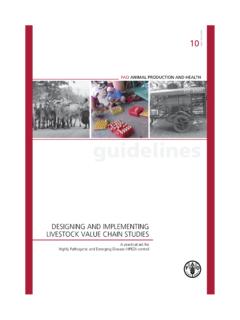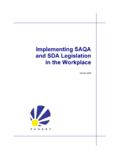Transcription of Implementing Lockbox - anilrpatil.com
1 Implementing Lockbox Your step-by-step guide for Implementing Oracle Receivables Lockbox functionality Product: Oracle Receivables Version: Release 12. Anil R. Patil Implementing Lockbox Contents Objective .. 3. Overview of Lockbox .. 3. Implementing Oracle Receivables Lockbox functionality .. 4. Setup Overview .. 4. Bank and Bank Accounts .. 5. Receipt Class & Receipt Method .. 7. Receipt Method Bank Accounts .. 9. Receipt Source .. 10. Lockbox .. 11. Transmission Formats .. 15. Transmission Fields .. 17. AutoCash Rule Sets .. 20. Control File .. 21. Data File .. 22. Lockbox Processing Steps .. 25. Submit Lockbox Process .. 26. Maintain Transmission Data .. 28. Identifying Customers for Receipts .. 30.
2 Conclusion .. 31. Page 2. Implementing Lockbox Objective The Objective of this document is to explain how to use the Oracle Receivables Lockbox functionality. This document will explain some of the key setups required for Implementing Lockbox and will guide you for setting up the Lockbox format and also generating a sample Lockbox file for testing purpose. Overview of Lockbox Lockbox is a service offered by banks to companies in which the company receives payments from their customers by mail to a post office box and the bank picks up the payments and deposits it in the company's bank account. In a way, the company is outsourcing its AR function of collecting the checks and depositing it in the bank.
3 The bank then informs the company of all the payments received. They normally send a Flat file (text file) to the company that gives all the details of the deposits made in the bank account. The details captured in the flat file depend on the arrangement between the bank and the company. This flat file is referred to as the Lockbox file. The company can then import this Lockbox file in their system to create receipts and apply these receipts to the open invoices. Oracle Receivables provide a standard functionality to import the Lockbox file to create the receipts. It also provides you with the flexibility to define customized Lockbox formats to enable you to accept the Lockbox file in any format for any of the banks.
4 The Oracle Lockbox functionality can also be extended to convert Receipts information from any other legacy system or from the remittance advice the company gets directly from their customers. Implementing a Lockbox solution by importing a Lockbox file from the bank goes beyond just Oracle Receivables configurations. You need to contact the bank, discuss and agree on the Lockbox file format before you start your work on Oracle Receivables. You need to decide how much information you want the bank to capture, how the bank will capture the information and so on. In most cases, the bank captures the remittance information by scanning the scan-line included in the payment coupon. This payment coupon is sent to the customers along with the Invoice (Generally the bottom of the first page of the Invoice).
5 The scan-line will include information such as Account number, remittance amount, invoice number and so on. This is how a typical payment coupon looks like Once the bank receives the payment along with the payment coupon, the bank scans the Scan line to capture the required information to be included in the Lockbox file. Each digit in the scan line indicates some important information. For the last 5 digits in the scan line above indicate the amount. Page 3. Implementing Lockbox Implementing Oracle Receivables Lockbox functionality Setup Overview You need to setup the following before running the Lockbox process 1) Bank and Bank Accounts: You define your internal bank accounts in Accounts Receivables.
6 This is the bank account where the customer payments are deposited. 2) Receipt Class: The Receipt Class determines the processing steps for the receipts and you assign Receipt Methods to your Receipt Class. The processing steps for any Receipt include confirmation, remittance and reconciliation. 3) Receipt Method: Receipt Method is assigned to a receipt class and it determines how to account for the receipts using the Receipt Class. For one Receipt Class, you can have more than one Receipt Methods. You associate bank accounts and the GL account combinations for Cash, Remittance, and Bank Charges etc with the Receipt Method. 4) Receipt Source: You define Receipt Batch Sources to provide default values for Receipt Class, Receipt Method and the Remittance Bank Account.
7 Your Receipt Source also determines if the batch numbering system is manual or automatic. 5) Lockbox : Define a Lockbox for your Lockbox service from each bank. The Lockbox setup includes a Lockbox number (You get a Lockbox number from your bank). 6) Lockbox Transmission Formats: Oracle Receivables AutoLockbox uses the Transmission format while importing the data from the Lockbox file into Receivables. Transmission formats indicate how the data in the Lockbox file is organized. 7) AutoCash Rule Sets: AutoCash Rule Sets determines the sequence of AutoCash Rules that Post QuickCash program uses to apply the receipt amount to the customer account open items. 8) Control file: A Control file is a sql loader file to load the Lockbox file in Receivables payment interface table (ar_payments_interface_all).
8 This file should have the .ctl' extension and should be placed in the $AR_TOP/bin directory. Input Data 1) Lockbox file: The only input data you need for the Lockbox process is the Lockbox file (flat file). You receive this file from the bank. If you are using the Lockbox functionality to convert AR receipts from legacy system, you can generate this file yourself. Page 4. Implementing Lockbox Bank and Bank Accounts Navigation: Setup => Receipts => Banks (You could also setup Banks from Cash Management responsibility). You define your internal bank accounts in Accounts Receivables. This is the bank account where the customer payments are deposited. Please note that the Bank setup and the bank security access have changed in Release 12.
9 For more details on bank security access, you can refer the following metalink document - How to Setup Bank Account Access Security In Release 12. You also need to run the CE UMX Security Wizard to be able to provide Bank Account access to Legal entities. Follow the following steps to run the wizard 1) Log in as Sysadmin. 2) Go to the User Management Responsibility. 3) Path: Roles & Role Inheritance 4) In the Type field select Roles and Responsibilities 5) Wait until a new field appears, you will see the category field, please select Miscellaneous 6) In the Application select 'Cash Management' and click on GO button. 7) Search your Cash Management responsibility (Hit go) and look for role <Cash Management Responsibility Name>.
10 8) Click on the update icon for role <Cash Management Responsibility Name>. 9) A new window will be displayed, please click in the Security wizard Tab. Hit Save and Proceed . 10) For CE UMX Security wizard click on the Run Wizard. 11) In this window you should add the legal entities that you want to grant the access to all the bank accounts within a legal entity and choose the privileges that you want to assign to this role on the bank accounts such as: USE, MAINTENANCE and BANK ACCOUNT TRANSFERS. Page 5. Implementing Lockbox 12) Click Add Legal Entities . Click Go and then select the legal entities from the list. Next screen select all required options for the legal entities and hit Apply . On the next screen also hit Apply.








